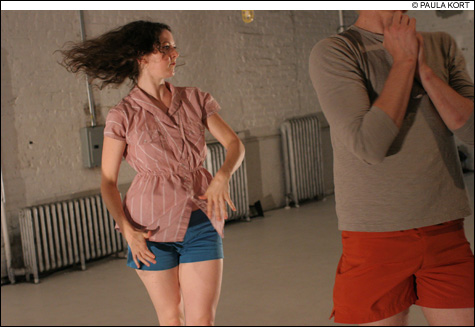
RAMMED EARTH Tere O’Connor’s piece examines social behavior as quirky, brainy, and possibly
purposeless. |
“Beauty Ecstasy Serenity Anxiety” is how Margaret Leng Tan inscribed the CD liner notes on some of the music she played for Eiko & Koma’s Mourning last Thursday at Concord Academy Summer Stages Dance. Those words could have described not only the powerful piano pieces by John Cage, Bunita Marcus, and Somei Satoh but also the dance itself. With the most unassertive, seemingly egoless moves, Eiko & Koma can evoke the sensations and moods of a universe, and Tan matched them in theatrical as well as musical intensity.
As she strokes a prepared piano, with each key tuned to two tones that produce eerie overtones (Cage’s In the Name of the Holocaust), you look at a leaf-covered ramp and a high, indeterminate brown shape with leaves or shreds of bark peeling off its surface. Two bodies lie in the leaf litter, their heads straining back toward the audience. Shadowing this tableau was my own unforgettable picture of the World Trade Center collapsing on 9/11.
All of Eiko & Koma’s concerns are in this first image: the fusion of human and natural worlds; the stillness; the mysterious open metaphors that slowly shift under changing light and sound and movement. Mourning is based on some of their earlier pieces, like Offering, which was seen at Northeastern University in 2003. But in a way, you could say all their pieces are one piece, with slight changes of focus. The constant element is their earthbound, polymorphous movement.
As they begin to edge toward each other in the leaves, you can see distinct differences between them. Koma’s moves are effortful, spasmodic. He seems to be working against himself even when he’s covering a minute distance or giving in to gravity. Eiko slips through the slowest, oddest rotations. She seems to have no joints, but there are times when she looks broken, her limbs dangling or horribly wounded. Both of them are naked except for black furry sacks that encase their torsos. You hardly ever see their faces, and they never stand upright on their own two legs.
Koma often seems like some lumbering animal, butting Eiko’s curled-up body from behind or reaching out an inarticulate hand to touch her. She claws at bunches of leaves. She slides onto him, hurls into him without using her arms. They make tiny moans and toothy hisses and grunts. They keep colliding in some kind of sexual need, then rolling apart.
Into a recorded piano vibration, Tan adds tone clusters that build into a chaos of loud repeated notes as she hammers the keyboard with flat hands, only to subside and build again (Somei Satoh’s Litania). During this long upheaval of sound, Koma mounts Eiko, gently at first. Then with sudden fury he whacks the ground with a piece of leather he’s rooted out of the litter, then rubs it over her body. She emits one loud, weird scream. He crouches over her and seems to be devouring her entrails. Then he inches down the ramp again.
Next time he appears, he’s carrying a big bundle of green branches that he presses against her body, and together they struggle to rise, merging with the foliage — a tree pushing up from the ground, a creature giving birth.